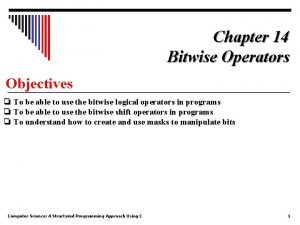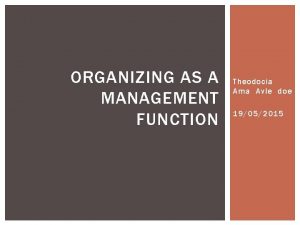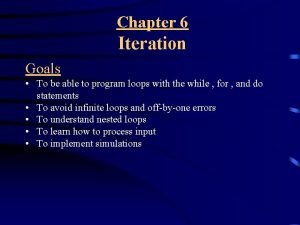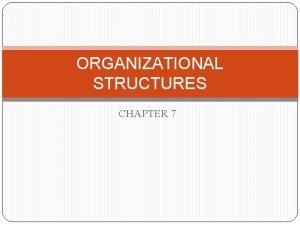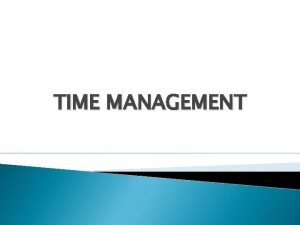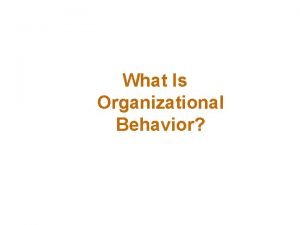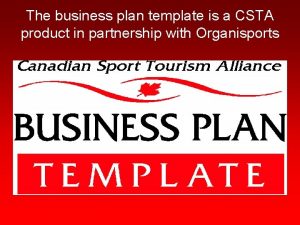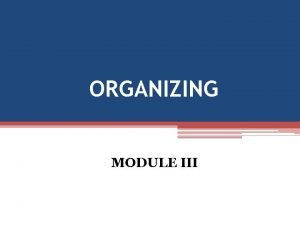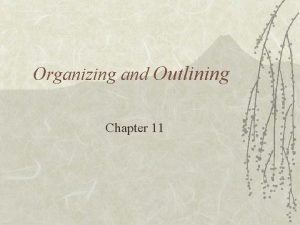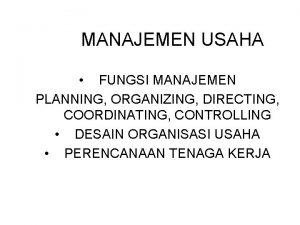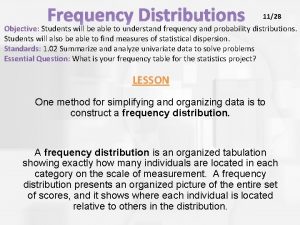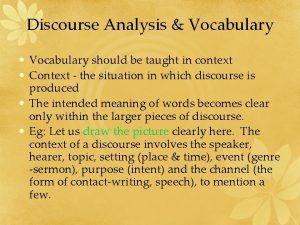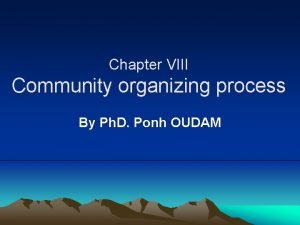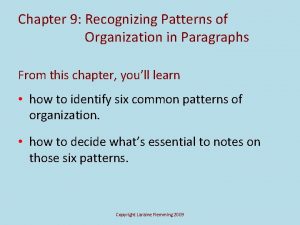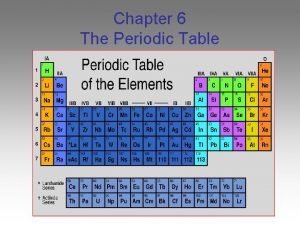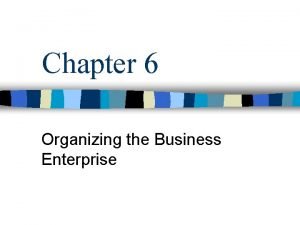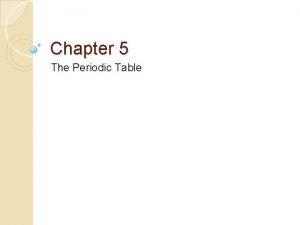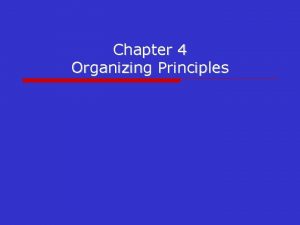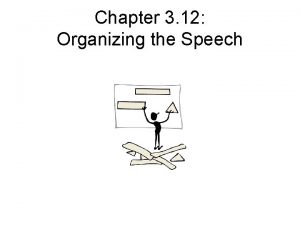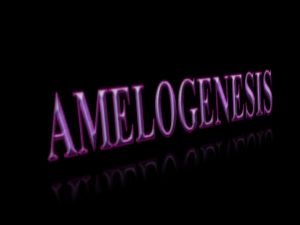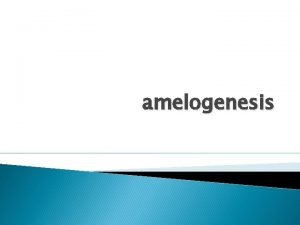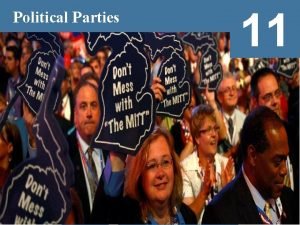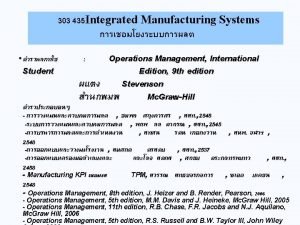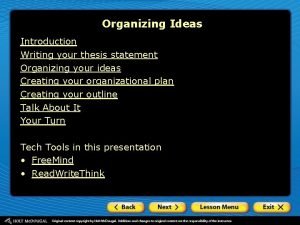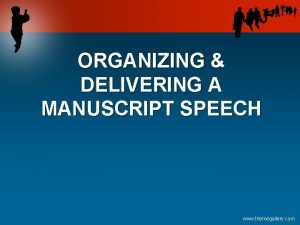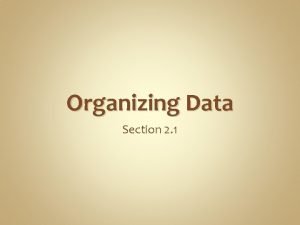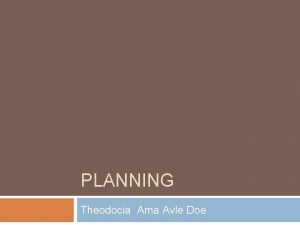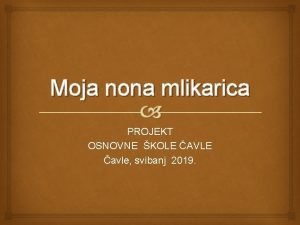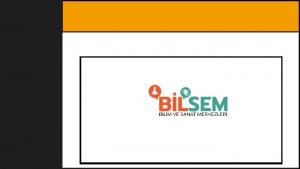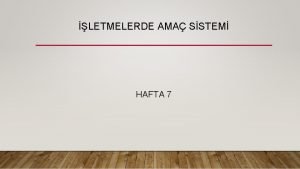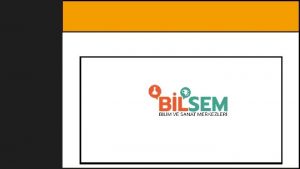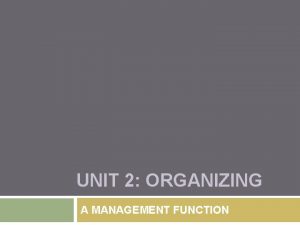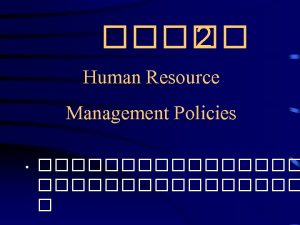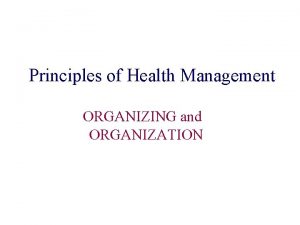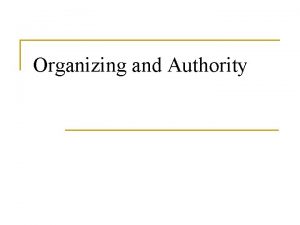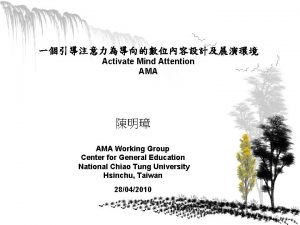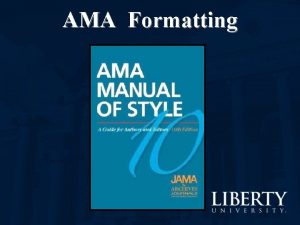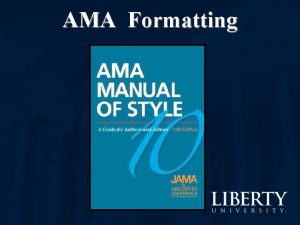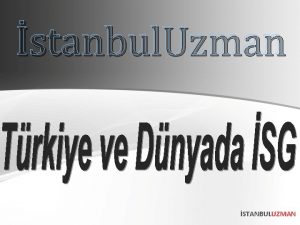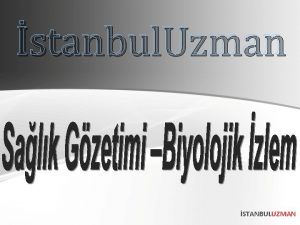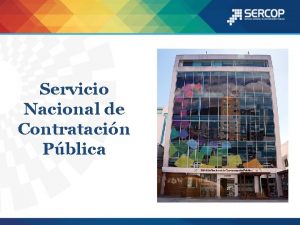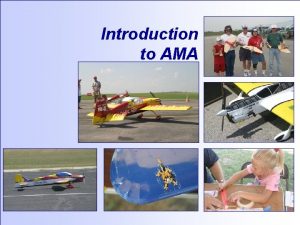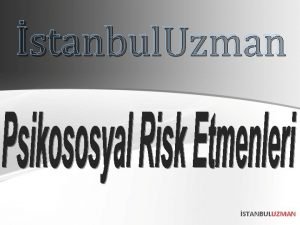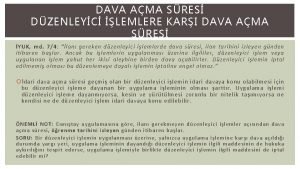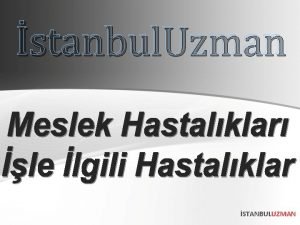ORGANIZING AS A MANAGEMENT FUNCTION Theodocia Ama Avle





























![Type of Work function or activities (marketing, production[health service], finance). If structure is Type of Work function or activities (marketing, production[health service], finance). If structure is](https://slidetodoc.com/presentation_image_h/85c3722036a3e67b0e55f3ca9c6da131/image-30.jpg)















- Slides: 45

ORGANIZING AS A MANAGEMENT FUNCTION Theodocia Ama Avle doe 19/05/2015

Session objectives By the end of this session students should acquire 1. understanding of organizing function 2. insight into major components of organizational structure and charts 3. Knowledge about formal and informal organization 4. Understanding of Hierarchy and span of control

INTRODUCTION Organizing is defined as the process of establishing orderly use of all resources within the management system It emphasizes attainment of objectives and assist managers in making objectives clear and clarifying resources that would be used to attain them.

Organizing also refers also how activities are divided up grouped and coordinated. (grouping of activities, assigning each grouping to a manager with the authority necessary to supervise them)

Every organizational resource represent an investment to which a return has to be made Organization of resources increases efficiency and effectiveness

Henry Fayol developed 16 general guidelines for organizing resources 1. judiciously prepare and execute operating plan 2. organize human and materials to be in line with objective and resources 3. establish single competent guiding authority 4. Coordinate all activities and efforts

FAYOL 16 GENERAL GUIDELINES FOR ORGANIZING RESOURCES 5. Formulate precise, distinct and clear decisions 6. Arrange for efficient selection so that each department is headed by a competent, energetic manager and each employee is placed where he can render greatest service

16 GENERAL GUIDELINES FOR ORGANIZING RESOURCES 7. define duties 8. Encourage initiative and responsibility 9. Fair and suitable rewards for services rendered 10. Use of sanctions against faults and errors 11. Maintain discipline 12. Ensure individual interest are consistent with general interest of the organization

16 GENERAL GUIDELINES FOR ORGANIZING RESOURCES 13. Recognize unity of command 14. Promote material and human coordination 15. Institute and effect controls 16. Avoid regulation, red tape and paperwork

IMPORTANCE OF ORGANIZING Mechanism with which managers activate plans Creates and maintains relationship between and among organizational resources (which resources to be used for specific activity, when, where and how the resources are to be used) Prevent duplication of efforts

ORGANIZING PROCESS Five steps Reflect on objectives Establish major tasks Divide major task into sub tasks Allocating resources and directives for subtask Evaluate results of implemented strategy The steps should be repeated so as to help get useful feedback for improvement

Organizing showing how activities are divided up grouped and coordinated is shown on an organizational structure Structure is set forth by the design of the major components or subsystems; showing pattern of relationships, In the formal sense structure is set fourth by organizational charts, by positions and job descriptions, and by rules and procedures Structure is also concerned with patterns of authority, communication and workflow providing formal relation between technical and psychosocial system

The structure of a social system (organization)is not visible but can be inferred from actual operation and behavior of the organization. Though the structure of organization can not be looked as separate from its functions, the two are two separate phenomena

ORGANIZING THEORY Classical organizing theory –insight into how organization resources can be best used for best goal attainment. The most profound writer on classical organizing theory was Max Weber According to Max Weber – the main component of organizing effort include; - detailed procedures and rules-; - clearly outlined organizational hierarchy and mainly -impersonal relationships between organization members

Weber use the term bureaucracy to label management system that contain these components Criticisms of Weber’s bureaucracy—state the lack of concern for human variables within the organization

Main consideration from classical organizing theory; Four main consideration from classical organizing theory all modern managers should include in their organizing efforts are 1. Structure 2. Division of labor 3. Span of control 4. Scalar relationships

Structure Managers must choose appropriate structure Structure refers to designated relationships among resources of the management system; Structure helps to facilitate use of each resource individually or collectively

Structure; shows pattern of relationships, In the formal sense structure is set fourth by positions and job descriptions, and by rules and procedures Structure is also concerned with patterns of authority, communication and workflow providing formal relationship between technical and psychosocial system

Structure is primarily represented by graphic illustration known as organizational chart-; graphic illustration of authority and responsibility Organization chart is traditionally constructed in a pyramid form, with individuals towards top having more authority and responsibility than those towards bottom.

Talcot Parson defined organizational structure as ‘ an expression of rational action and involves institutionalized pattern and procedures which hold in an authoritative manner’

In reality two basic Types of organizational structure exist within management system Formal and informal Formal organizational structure- is defined as relationships between organizational resources and it is represented primarily by organizational chart Informal structure-; is defined as patterns of relationships that develop as a result of informal existence of organization members. It evolves naturally and tend to be molded by individual norms, values and or social relationships. It coexist with formal organization but not necessarily identical to it

IMPORTANCE OF ORG. STRUCTURE 1. Contributes to successful implantation of plans – formal allocation of people and resources 2. Members of org. know what is expected from them; structure and operating mechanisms for coordination clearly spelt 3. Helps in decision-making and its associated information processing

Major components of organizational structure 1. The basic structure-; allocation of people and resources , mechanisms for coordination, / formal pattern of relationship and duties – takes the form of job description, organizational charts, committees, task force 2. Differentiation – ways various activities or tasks are assigned to different departments and or people in the organization. [2 ways; vertical and horizontal differentiation]. Vertical is about hierarchy (DDNS, PNO, SNO, SSN, SN) Horizontal same as departmentalization

3. Integration- how separate activities are coordinated 4. Authority system i. e. power status 5. Administrative system- planned and formal policies, procedures, controls that guide activities and relationships

Organization chart convey the following useful information Division of labor- position to which work is assigned along with someone to do it Type of work performed-; formal titles tells about the nature of work assignee to the position holder Supervisor-subordinate relationships-; lines between positions show who reports to whom in the hierarchy of authority

Formal communication channel- lines on chart show formal channels for information movement throughout the organization Major subunits-position grouped together under managers form subunits, usually called divisions or department Levels of management- vertical linkages show management levels in the entire hierarchy of authority



FORMAL STRUCTURE AND DEPARTMENTALIZATION Formal relationship between resources are established by departments A department is a unique group of resources established by mgt. to perform organizational task. The process known as departmentalization, is based on situational factors such as work functions being performed, the product being assembled, the territory to be covered the target customer and the process designed to manufacture a particular product
![Type of Work function or activities marketing productionhealth service finance If structure is Type of Work function or activities (marketing, production[health service], finance). If structure is](https://slidetodoc.com/presentation_image_h/85c3722036a3e67b0e55f3ca9c6da131/image-30.jpg)
Type of Work function or activities (marketing, production[health service], finance). If structure is based on function workers and other resources are departmentalized accordingly Structure based on productdepartmentalization is based on the type of product.

E. g producing medical equipment Resources needed to produce each product for example in producing medical equipment-; Structure based on territory departmentalize according to the place work is done or the geographical market for the product As Market areas and work locations expand, management tasks become cumbersome; to overcome or minimize the effect of distances, resources are departmentalized according to location

Structure based on customer, establishes department in response to major customer; based on the assumption that major customers can be identified and divided into logical categories Structure based on process departmentalize according to major phases of the process used to manufacture products

FORCES INFLUENCING FORMAL STRUCTURE 1. forces in the manager 2. Forces in the task 3. Forces in the environment 4. Forces in the subordinate

1. Forces In The Manager -; the unique way manager perceives organizational problems ( personality), background, knowledge, experience, values, influence his or her perception of how formal structure should exist or be changed 2. Forces in the task [ include degree of technology involved in the task, complexity of the task

3. Forces in the environment [ customers, suppliers, social and political structures 4. Forces in the subordinate[ needs, skill level, As the environment and subordinates vary forces are created to change the org. forces

DIVISION OF LABOR The second main consideration of organizing effort is how to divide labor i. e. the assignment of portions of task among org. members; several individuals perform different parts of total activity. In effect, individuals specialize in doing part of the task. For example in production of car Advantages; 1. As workers specialize in a particular task -; Skills increase 2. Workers do not lose valuable time in moving from one task to the other 3. increase productivity and efficiency

Disadvantages of division of labor 1. Work tends to be boring may reduce production rate

Division of labor requires coordination for efficiency Coordination defined by Mooney ‘ the orderly arrangement of group effort to provide unit of action in the pursuit of a common purpose’

Span of management or span of control The 3 rd main consideration of organizing effort is span of management Span of management refers to the number of individuals a manager supervises Greater span of control means manager supervises a lot of individuals, smaller span of control implies the manager has only a few individuals to supervise

To use human resources efficiently managers should supervise as many individuals as they can best guide towards goals; supervising too few may waste productive capacity; too many too may reduce efficiency

For adequate span of control Harold Koontz suggested the use of situational factors to guide managers in designing the span of control 1. similarity of functions- the degree to which activities performed by the supervised are similar or dissimilar (similar activities easy supervision ) 2. geographical contiguity- degree of physical separation; the closer the subordinates are physically the more mangers are able to effectively manage 3. complexity of function-the more difficult and involving activities, the more difficult it is for the managers to effectively supervise

4. coordination- the amount of time managers must spend to synchronize activities of their subordinates with the activities of other workers. If great then the span of control should be small 5. Planning[ more time spent on planning, less time for supervision]

Tall and flat organization- this reflects the span of control i. e. the number of subordinates working for the superior, it defines the shape of the org. The greater the height of the org. chart the smaller the span of control The smaller the height the greater span of control Tall or flat Tall has large number of managerial hierarchies Advantages-increases commitment, Flat organization has small number of hierarchy levels

Scalar relationships The 4 t h consideration of any organizing effort is scalar relationship It refers to a chain of command. Assumption -; Individuals at the top possesses the most authority, the lower the position on the organization chart the less authority The scalar relationship is related to the unity of command concept; a concept that recommends that an individual should have only one boss -; too many people giving command result in confusion, contradiction, frustration== ineffectiveness and inefficiency

Scalar chain- this describes org. ’s hierarchy i. e. the chain of superiors from lowest to highest rank Chain of command-; it refers to a line of authority from the top of the management hierarchy to employees at the bottom
 And operator table
And operator table Avle chapter 3
Avle chapter 3 Which statement is true about iteration goals?
Which statement is true about iteration goals? Organizing in management
Organizing in management Time management is the process of organizing and planning
Time management is the process of organizing and planning Time management is the process of organizing and planning
Time management is the process of organizing and planning Ob model
Ob model Introduction of portfolio
Introduction of portfolio Planning organizing directing and controlling are the
Planning organizing directing and controlling are the Organizing committee structure for an event
Organizing committee structure for an event Organizing for action strategy implementation
Organizing for action strategy implementation Planning organising staffing directing controlling
Planning organising staffing directing controlling Organizing students to practice and deepen knowledge
Organizing students to practice and deepen knowledge Work specialization
Work specialization English paragraph
English paragraph Organizing an outline
Organizing an outline Directing manajemen
Directing manajemen Organizing data in a traditional file environment
Organizing data in a traditional file environment A manager is someone who
A manager is someone who Organizing data using frequency distribution
Organizing data using frequency distribution Discourse analysis and vocabulary
Discourse analysis and vocabulary Core group formation meaning
Core group formation meaning Listing pattern of organization
Listing pattern of organization The periodic table displays the symbols and
The periodic table displays the symbols and Organizational structuring
Organizational structuring Organizing the periodic table
Organizing the periodic table Organizing principles
Organizing principles Circular organizational arrangement
Circular organizational arrangement Organizing lifes diversity
Organizing lifes diversity Human resources today
Human resources today Human resource management chapter 1
Human resource management chapter 1 Proliene
Proliene Maturation stage of amelogenesis
Maturation stage of amelogenesis Organizing government
Organizing government Organizing concept
Organizing concept Marzano element 15
Marzano element 15 Organizing students to interact with content
Organizing students to interact with content Organizing statement
Organizing statement Organizing in spanish
Organizing in spanish Organizing and delivering an entertainment speech
Organizing and delivering an entertainment speech How to organize qualitative data
How to organize qualitative data How to deliver an entertainment speech
How to deliver an entertainment speech Elements of organizing
Elements of organizing Planning organizing staffing writing
Planning organizing staffing writing Basic elements of organizing
Basic elements of organizing 6.1 organizing the elements
6.1 organizing the elements
